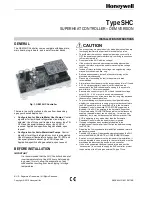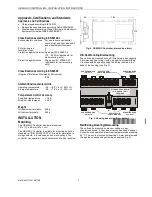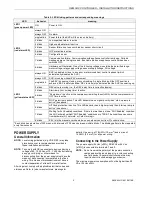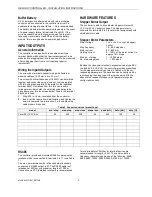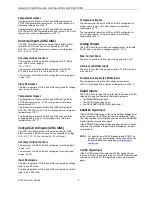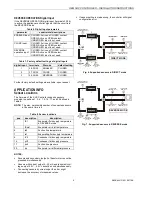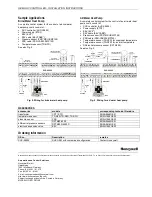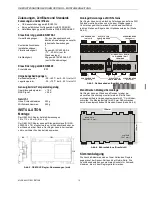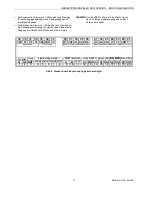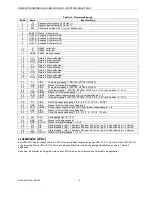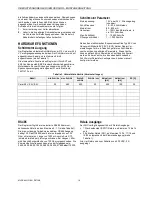
OEM SHC CONTROLLER – INSTALLATION INSTRUCTIONS
MU1B-0441GE51 R0710B
5
Table 2. LED blinking patterns and corresponding meanings
LED
behavior
meaning
LED 1
(green power LED)
ON
Power is ON.
LED 2
(red alarm LED)
always ON
--
always OFF
No alarm
single blink
Power failure (the SHC will then run on battery)
2 blinks
Low superheat alarm is active
3 blinks
High superheat alarm is active
4 blinks
Sensor failure due to sensor break or sensor short-circuit
5 blinks
LOP protection is active
6 blinks
Configuration error
7 blinks
Communication failure. Communication with appliance controller is missing. Periodic
messages are not being received. Bus cable broken or appliance controller has been
switched OFF.
8 blinks
Hardware self-test alarm. One of the following voltages is outside the permitted range:
motor voltage, relay supply voltage, sensor supply voltage, AO voltage
LED 3
(yellow status LED)
always ON
SHC is disabled or (due to any error or alarm condition) control is absent (which
automatically disables the SHC)
always OFF
SHC is running without EEV movement
single blink
The EEV is opening, closing, or synchronizing. A single blink (until the OFF position is
achieved; EEV in safety position; REV to close) also indicates that the SHC is powering up.
2 blinks
REV valve is moving (i.e., the REV delay time is currently elapsing)
3 blinks
Start ramp (incl. holding time) is active
4 blinks
“Pump down” is active or the compressor is waiting to switch ON, but the compressor min.
OFF time is active.
5 blinks
MOP protection is active. This LED behavior has a higher priority than “start-up ramp is
active” (see above)
6 blinks
HITCond protection is active. This LED behavior has a higher priority than “start-up ramp is
active” (see above)
7 blinks
Waiting for ALL Enabled conditions. If there is more than just one “SHC Enabled” condition,
the SHC will wait until
all
“SHC Enabled” conditions are TRUE. The conditions can come
from hardware (DI), network, or Cold store logic.
8 blinks
EEV is in the manual override mode; no superheat control from PI control active.
*Each blink has a duration of 300 msec, with intervals of 300 msec between multiple blinks. The blinking pattern is then repeated
every few seconds.
POWER SUPPLY
General Information
NOTE:
Local wiring guidelines (e.g. VDE 0100) may take
precedence over recommendations provided in
these installation instructions.
NOTE:
To comply with CE requirements, devices having a
voltage of 50...1000 Vac or 75...1500 Vdc but lacking
a supply cord, plug, or other means for
disconnecting from the power supply must have the
means of disconnection incorporated in the fixed
wiring. This means of disconnection must have a
contact separation of at least 3 mm at all poles.
All wiring must comply with applicable electrical codes and
ordinances. Refer to job or manufacturers’ drawings for
details. Use a min. of 18 AWG (1.0 mm
2
) and a max. of
14 AWG (2.5 mm
2
) for all power wiring.
Connecting to the Power Supply
The power supply (24 Vac [±20%], 50/60 Hz or 24 Vdc
[±10%]) is connected to terminals 1 and 2.
NOTE:
Do not reverse the polarity of the power connection
cables and avoid ground loops (i.e. avoid connecting
one field device to several controllers as this may
result in short circuits damaging your device.
The maximum power consumption will not be higher than 50
VA at 24 Vac ±20%.

